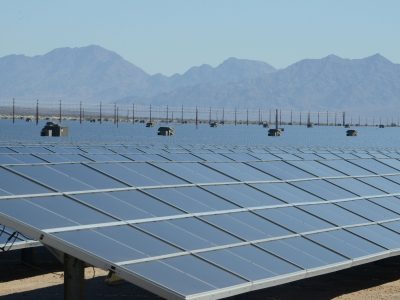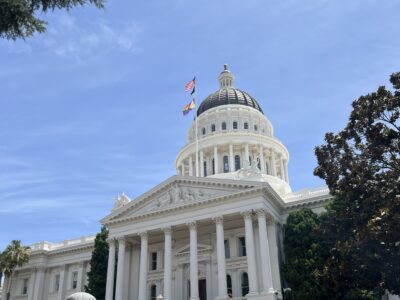EPA Releases Section 111(d) Rule for Existing Power Plants
Rule would reduce climate change-related carbon dioxide emissions from existing power plants 30 percent below 2005 levels by 2030
Today, EPA formally released its long-awaited rule to regulate carbon emissions from existing power plants under Clean Air Act § 111(d). Read the full text of the rule here.
As leaked to the media yesterday, the rule would have the overall effect of reducing carbon dioxide emissions from electric generating units (EGUs, or power plants) 30 percent below 2005 levels by 2030, with interim goals starting in 2020. Each state would have its own rate-based carbon dioxide emission standard (lbs of CO2/MWh), but may demonstrate compliance by meeting either the target rate or by converting the rate into a mass-based emission standard (e.g., tons of CO2/state/year). As I reported yesterday, the rule has grown out of EPA’s hundreds of meetings with key stakeholders over the past year. In a statement on Saturday, President Obama emphasized the public health benefits of the proposed rule.
The comment period will last 120 days, as Members of Congress requested. EPA will hold several public hearings in late July around the country. Under this proposed rule, states must submit state plans describing how they will implement the rule by June 30, 2016.
I provided context for the rule in my post yesterday, including background on §111(d) and an introduction to the main legal questions, and Ann followed up with an excellent review of ways the rule is business-friendly. Below are a highlights from the proposed rule.
Importantly, EPA recognizes the value of “outside the fenceline” systems of emission reduction. (See my post yesterday for discussion of the extant legal controversy over “outside the fenceline” reductions.)
[T]he most cost-effective system of emission reduction for GHG emissions from the power sector under CAA section 111(d) entails not only improving the efficiency of fossil fuel-fired EGUs, but also addressing their utilization by taking advantage of opportunities for lower-emitting generation and reduced electricity demand across the electricity system’s interconnecting network or grid.
. . . . EPA is proposing that states could choose approaches in their compliance plans under which full responsibility for actions achieving reductions is not placed entirely upon emitting EGUs; instead, state plans could include measures and policies (e.g., demand-side energy efficiency programs and renewable portfolio standards) for which the state itself is responsible. Of course, individual states would also have the option of structuring programs (e.g., allowance-trading programs) under which full responsibility rests on the affected EGUs.
The rule allows states broad discretion to achieve the 2030 target through a variety of flexible measures so as not to interfere with the reliability and affordability of electricity supply. EPA determined the best system of emission reduction (BSER) to be a combination of measures that can be grouped into four categories, or “building blocks”–1) power plant efficiency improvements, 2) redispatch (i.e., meeting demand with natural gas combined cycle plants instead of coal-fired plants), 3) nuclear and renewable energy generation, and 4) demand-side energy efficiency. The first block represents “inside the fenceline” changes, while the latter three blocks represent “outside the fenceline” emission reduction opportunities. EPA is explicitly seeking “comment on application of only the first two building blocks as the basis for BSER, while noting that application of only the first two building blocks achieves fewer CO2 reductions at a higher cost.”
For purposes of expressing the BSER as an emission limitation, in this case in the form of state-level goals, we propose to base these two approaches on measures grouped into four main categories, or “building blocks.” These building blocks can also be used as a guide to states for constructing broad-based, cost-effective, long-term strategies to reduce CO2 emissions. The EPA believes that the application of measures from each of the building blocks can achieve CO2 emission reductions at fossil fuel-fired EGUs such that, when combined with measures from other building blocks, the measures represent the “best system of emission reduction … adequately demonstrated” for fossil fuel-fired EGUs. The building blocks are:
1. Reducing the carbon intensity of generation at individual affected EGUs through heat rate improvements.
2. Reducing emissions from the most carbon-intensive affected EGUs in the amount that results from substituting generation at those EGUs with generation from less carbon-intensive affected EGUs (including NGCC units under construction).
3. Reducing emissions from affected EGUs in the amount that results from substituting generation at those EGUs with expanded low- or zero-carbon generation.
4. Reducing emissions from affected EGUs in the amount that results from the use of demand-side energy efficiency that reduces the amount of generation required.
. . . . The combination of all four blocks best represents the BSER because it achieves greater emission reductions at a lower cost, takes better advantage of the wide range of measures that states, cities, towns and utilities are already using to reduce CO2 from EGUs and reflects the integrated nature of the electricity system and the diversity of electricity generation technology.
Notably, the rule allows states to collaborate on multi-state plans if they so choose, which “may provide additional opportunities for cost savings and flexibility.” In general, the rule recognizes existing state climate mitigation programs such as renewable portfolio standards (RPSs):
Importantly, states may rely on measures that they already have in place, including renewable energy standards and demand-side energy efficiency programs, and the proposal details how such existing state programs can be incorporated into state plans. States will also be able to participate in multi-state programs that already exist or may create new ones.
The rule also discusses the issue of enforceability in the context of existing climate mitigation programs in California and the Regional Greenhouse Gas Initiative (RGGI) states in the Northeast, and explicitly states that EGU emission reductions associated with such programs can qualify under the rule:
EPA . . . heard from a wide range of stakeholders that the EPA should authorize state plans to include a portfolio of actions that encompass a diverse set of programs and measures that achieve either a rate-based or mass-based emission performance level for affected EGUs but that do not place legal responsibility for achieving the entire amount of the emission performance level on the affected EGUs. In view of this strong sentiment from stakeholders, the EPA is proposing that state plans that take this portfolio approach would be approvable, provided that they meet other key requirements such as achieving the required emission reductions over the appropriate timeframes. Plans that do directly assure that affected EGUs achieve all of the required emission reductions (such as the mass-based programs being implemented in California and the RGGI states) would also be approvable provided that they meet other key requirements, such as achieving the required emission reductions over the appropriate timeframes.
As discussed above, the rule includes a 2030 end goal specific to each state, plus state-specific interim goals beginning in 2020. EPA “is also requesting comment on an alternative option,a 5-year period for compliance, in combination with a less stringent set of CO2 emission performance levels.” Numerous considerations underpin the state-specific goals.
To set the state-specific CO2 goals, the EPA analyzed the practical and affordable strategies that states and utilities are already using to lower carbon pollution from the power sector. These strategies include improvements in efficiency at carbon-intensive power plants, programs that enhance the dispatch priority of, and spur private investments in, low emitting and renewable power sources, as well as programs that help homes and businesses use electricity more efficiently. In addition, in calculating each state’s CO2 goal, the EPA took into consideration the state’s fuel mix, its electricity market and numerous other factors. . . . The proposed final goals reflect the EPA’s quantification of adjusted state-average emission rates from affected EGUs that could be achieved at reasonable cost by 2030 through implementation of the four building blocks described above.
Here are several of the proposed state goals (you can find a full list in Table 8 of the Proposed Rule):
Proposed State Goals (Adjusted Output-Weighted-Average Pounds of CO2 Per Net MWh From All Affected Fossil Fuel-Fired EGUs)
State CaliforniaColorado New York
North Carolina
Texas
Interim Goal 5561159 635
1077
853
Final Goal 5371108 549
992
791
EPA highlights that the rule’s 2030 goals are achievable:
because innovations in the production, distribution and use of electricity are already making the power sector more efficient and sustainable while maintaining an affordable, reliable and diverse energy mix. This proposed rule would reinforce and continue this progress. The EPA projects that, in 2030, the significant reductions in the harmful carbon pollution and in other air pollution, to which this rule would lead, would result in net climate and health benefits of $48 billion to $82 billion. At the same time, coal and natural gas would remain the two leading sources of electricity generation in the U.S., with each providing more than 30 percent of the projected generation.
The proposed rule includes guidelines for state plans, which include “approvability criteria, requirements for state plan components, the process and timing for state plan submittal and the process and timing for demonstrating achievement of the CO2 emission performance level in the state plan.”
EPA also addressed the costs and benefits of the proposed rule:
Assuming that states comply with the guidelines collaboratively (referred to as the regional compliance approach), the EPA estimates that, . . . [i]n 2030, total compliance costs for the proposed option regional approach are approximately $7.3 billion (2011$). The net benefits for this proposal increase to approximately $48 billion to $82 billion (3 percent discount rate model average, 2011$) in 2030 . . . .
There are additional important benefits that the EPA could not monetize. These unquantified benefits include climate benefits from reducing emissions of non-CO2 greenhouse gases (e.g., nitrous oxide and methane)13 and co-benefits from reducing direct exposure to SO2, NOx and hazardous air pollutants (e.g., mercury and hydrogen chloride), as well as from reducing ecosystem effects and visibility impairment. . . .
In 2020, we project job growth of 25,900 to 28,000 job-years in the power production and fuel extraction sectors, and we project an increase of 78,000 jobs in the demand-side energy efficiency sector.
Read the full text of the 645-page proposed rule here.







Reader Comments